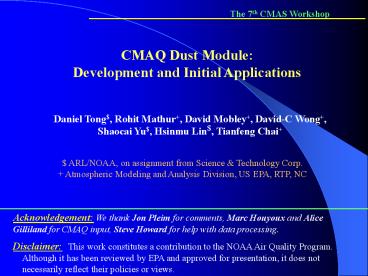CMAQ Dust Module: PowerPoint PPT Presentation
1 / 18
Title: CMAQ Dust Module:
1
The 7th
CMAS Workshop
CMAQ Dust Module Development and Initial
Applications
Daniel Tong, Rohit Mathur, David Mobley,
David-C Wong, Shaocai Yu, Hsinmu Lin, Tianfeng
Chai
ARL/NOAA, on assignment from Science
Technology Corp. Atmospheric Modeling and
Analysis Division, US EPA, RTP, NC
Acknowledgement We thank Jon Pleim for comments,
Marc Houyoux and Alice Gilliland for CMAQ input,
Steve Howard for help with data processing.
Disclaimer This work constitutes a
contribution to the NOAA Air Quality Program.
Although it has been reviewed by EPA and approved
for presentation, it does not necessarily reflect
their policies or views.
2
Environmental Impacts of Dust Particles
Climate
- Direct absorbing scattering
- Indirect CCN
- Bio-available iron ? phytoplankton ?
CO2 sink
Atmospheric Chemistry
- Reduce photolysis rates by over 50
- Reacting platform for O3, HO2 and N2O5
- Buffering acid rain
Air Quality
- Reduce visibility
- PM air quality standards
Human Health
- Sources for toxic metals
- Ubiquitous constituents of inhalable PM
(Source IPCC, 2007)
3
PM2.5 Emissions in the U.S.
(Source US EPA, NEI Air Pollutant Emissions
Trends, 2006)
4
Calculating Natural Dust Emissions in U.S.
Key factors
- Dessert and agricultural land
- Soil moisture (rain snow cover)
- Soil components (sand, silt and clay)
- Vegetation coverage and roughness
- Surface wind speed)
- Threshold wind speeds
(Source blog.maricopanewhomes.net)
5
Dust Emission Algorithm
Dust production using Owens Equation
(Marticorena et al, 1997)
Threshold Friction Velocity (source Gillette
1980, 1988)
6
Size Distribution Chemical Speciation
Size Distribution -- Bins (source Marticorena et
al, 1995 Ginoux et al., 2001 Draxler et al.,
2001)
- Threshold wind speeds from wind tunnel
experiments - Threshold values dependent on average particle
sizes for each bin
Chemical Speciation (Pelt Zobek, 2007 Ansley
et al., 2006)
- 99 of PM2.5 emissions into PMFINE (eventually
A25J) - 1 of PM2.5 emissions into PSO4, PNO3, PEC
POA - 100 of PM2.5-10 emissions into PMC (eventually
ASOIL)
7
CMAQ Configuration
Emissions
- 2002 NEI for anthropogenic emissions
- BEIS 3 for biogenic emissions
- Year-specific wildfires and prescribed burning
- Natural dust emissions turning on and off.
Meteorology
- MM5 with Pleim-Xiu Land Surface module on
CMAQ (version 4.6)
- Jan. 1 Dec. 31, 2002
- Domain Continental US, N Mexico and S. Canada
- MOZART-2 for lateral boundary conditions
- CB05 gas chemistry and AE4 aerosol modules
- Online calculation of photolysis rates
8
Natural Dust (PM2.5) Emissions in 2002
9
Dust Emissions over Western Canadian
10
Topography Filter
Impact of topography on dust availability
(Prospero et al., 2001)
11
Monthly Profile of U.S. Dust Emissions
Dust emissions most active in Spring
12
PM2.5 Emissions by Sector (2002)
Top PM2.5 emission sectors (and uncertainties!)
Miscellaneous (anthropogenic) and Natural
Emissions
13
Dust Impact on PM2.5 and O3
(a Major Dust Episode in late May 2002)
PM2.5 Change
O3 Change
Dust impact on O3 through reduced photolysis
rates only Direct interactions of O3 with dust
not implemented.
14
Dust Impact on PM2.5 Performance
(dust contribution lt 1 mg/m3)
Without Dust NMB -26.2
With Dust NMB -25.2
Outside dust plumes, the addition of natural PM
emissions improves CMAQ performance to predict
PM2.5
15
Dust Impact on PM2.5 Performance
(dust contribution 1 2 mg/m3)
Improved performance in areas of moderate impact
16
Dust Impact on PM2.5 Performance
(dust contribution gt 3 mg/m3)
Inside plume, resolved under-prediction, but
working too hard!
17
Conclusion
- Annual natural PM2.5 emissions in the U.S.
- Impact of natural emissions on air quality
simulation
- Contribute to 30 of primary PM2.5 emissions
(preliminary) - Most active in Spring
- Mostly from Southwest and Rocky Mountain regions
- Dust emissions affect both PM2.5 and O3
concurrently - The additional emissions improve CMAQ
performance for PM2.5, but cause over-prediction
inside the plume
18
Future Work
- Data verification
- Implementation for air quality forecast
- Comparison with more ground observations
- AOD calculation and comparison with satellite
data
- Change PREMAQ to extract soil type and moisture
from MET model - Update CMAQ codes to include dust module

